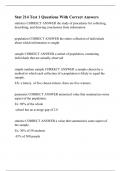BRILLIANT TUTORS
MNG3701
Assignment 2
DUE 16 September
2024tabby
[Year]
[Type the company address]
, Book
Practising Strategy
MNG3701 Assignment 2 Semester 2 2024) - DUE 16 September 2024 ; 100%
TRUSTED Complete, trusted solutions and explanations
Questions 1 a) Explain the importance of analysing the micro-environment.
Briefly explain any three approaches that can be used to analyse the micro-
environment.
Importance of Analyzing the Micro-Environment:
The micro-environment, also known as the task environment, refers to the immediate
surroundings that directly impact a business's operations. Analyzing this environment is crucial
because it provides insights into the factors that can make or break a company's success. Here's
why it's important:
Understanding Customers: By analyzing customer demographics, needs, and buying
behaviors, businesses can tailor products and services accordingly, leading to higher
customer satisfaction and loyalty.
Identifying Opportunities & Threats: Analyzing competitors' strengths and
weaknesses, supplier bargaining power, and potential substitutes for your product helps
identify opportunities to gain an edge and mitigate potential threats.
Developing Effective Strategies: Understanding the micro-environment allows
businesses to develop targeted marketing strategies, pricing strategies, and resource
allocation plans to achieve their goals.
Approaches to Analyze the Micro-Environment:
1. Porter's Five Forces Analysis: This framework examines five competitive forces: threat
of new entrants, bargaining power of suppliers, bargaining power of buyers, threat of
substitutes, and competitive rivalry within the industry. By analyzing these forces,
businesses can understand the overall attractiveness of their industry and develop
strategies to navigate the competitive landscape.
2. SWOT Analysis: This framework helps identify a company's Strengths, Weaknesses,
Opportunities, and Threats. Analyzing the micro-environment contributes heavily to
understanding internal strengths and weaknesses (e.g., employee skills, brand reputation)
and external opportunities and threats (e.g., new technologies, changing customer
preferences).
3. Customer Relationship Management (CRM) Analysis: CRM tools collect and analyze
customer data, providing insights into customer demographics, buying habits, and






